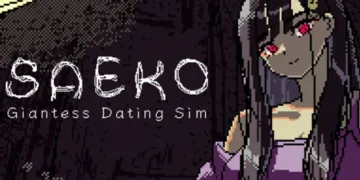Little Amélie begins where life does, but from a perspective none of us can consciously recall. The film’s narrator, Amélie, speaks to us from the fluid, silent world of the womb, where she reigns as a self-proclaimed deity, a mind without a body, a consciousness without a name.
When she is born to her Belgian family—a diplomat father and a musician mother—she enters the world as a tiny philosopher-queen trapped within a beautiful but physically inert body. To her family, she is an infant who only eats, sleeps, and observes.
This silent, watchful state is shattered when her father’s work relocates the family to the vibrant, unfamiliar landscape of Japan in the late 1960s. The move itself is a sensory jolt, a shift in light, sound, and atmosphere. It is here, at the age of two-and-a-half, that a minor earthquake and a revelatory taste of home coincide to awaken her.
This is not framed as a medical recovery but as a true birth of self, the poetic start of a profound journey. The film invites us to see the entire world for the very first time, unfiltered and astonishing, through the developing gaze of a child.
Drawing What It Feels Like
The film’s 2D animation is its most articulate and essential voice, a key element that elevates it beyond simple storytelling. It carries a rich, painterly quality, reminiscent of a cherished European storybook illustration brought to life with a palette of soft, expressive pastels.
This aesthetic choice, however, is not merely for charm; the visual world is a direct and fluid extension of Amélie’s mind. The story opens with a sequence of abstract, vivid colors and morphing shapes that represent her pre-verbal existence—a brilliant and immersive way to show a state of being rather than just telling us about it.
This technique of visualizing the internal is a clear departure from the slick, photorealistic trends in mainstream animation, aligning the film with more experimental independent works that prioritize emotional truth over technical gloss.
The animation breathes with Amélie’s perception. A mundane vacuum cleaner becomes a strange, roaring beast with a consuming snout, perfectly capturing a toddler’s mix of fear and fascination. When Amélie learns the Japanese character for her name, ‘ame,’ also means rain, a storm gives way to a breathtaking sequence where her own tiny image is reflected in each individual falling droplet.
I was reminded of my own childhood attempts to draw impossible things—the wind, a sound, a feeling. The film’s artists have managed to draw what it feels like to be small and new in the world, making Amélie’s internal state perfectly, beautifully tangible for the audience. This visual strategy ensures we are never just watching Amélie; we are experiencing the world with her.
Belgian Chocolate, Japanese Folklore
Amélie’s identity is forged at the fascinating intersection of two distinct worlds, a theme grounded in her most formative relationships. Her bond with Nishio-san, the family’s gentle Japanese nanny, becomes the film’s quiet, steady anchor.
Nishio-san offers far more than just care; she is a cultural and emotional guide who introduces Amélie to the rich tapestry of her new environment. Through her, Amélie learns about the spirits and monsters of Japanese folklore, the calming, communal rituals of the Obon festival for the dead, and the poetry hidden within her own name. This relationship provides Amélie with a sense of place and belonging, grounding her in the sights, sounds, and stories of Japan.
In a brilliant stroke of narrative balance, the catalyst for her physical awakening is distinctly Belgian: a single, decadent piece of white chocolate brought by her visiting grandmother. The intense, sweet flavor is a jolt to her senses, a powerful and tangible link to a heritage she has never known and a family history she is just beginning to understand.
It’s a taste of a home she doesn’t remember. These two powerful female influences—one representing her new world, the other her roots—provide the pillars for her burgeoning self. Their nurturing guidance is set against the more complicated backdrop of her relationships with her boisterous, sometimes cruel, older siblings and a somewhat frightening landlady, painting a full and honest picture of a young life shaped by gentle hands, sharp edges, and the constant negotiation between different cultures.
Small Shoulders, Big Questions
What makes Little Amélie so resonant and positions it as a significant piece of modern animation is its courage to address life’s most immense subjects through its tiny protagonist. The film gracefully explores grief, fear, and mortality from a perspective of pure, unfiltered curiosity.
It stands apart from conventional family films that often shield children from such topics. Here, Amélie encounters death not with adult dread but with a child’s questioning mind. We see it when she discovers her father weeping for his deceased mother, his large frame crumpled in a way that mystifies her, and again when she listens to Nishio-san recount her own harrowing past from the bombing of Kobe during the war.
There is a Japanese belief that children under the age of three are closer to the divine, and the film leans into this idea with profound effect. It suggests that Amélie’s unprocessed, non-judgmental view of existence gives her a unique purchase on these deep truths.
The film uses its visual language to explore memory itself, showing it not as a perfect recollection but as a series of powerful, dreamlike images. This is not a sad story. It is a quietly optimistic one, suggesting that memory is how we hold onto what is lost and that human connection is what gives life its meaning and texture. The film’s lasting impression is a powerful, meditative reflection on the sanctity of our formative years, where discovering the world—in all its beauty and sorrow—is the greatest adventure of all.
Little Amélie or the Character of Rain is a 77‑minute French-Belgian animated drama that premiered at the Cannes Film Festival on May 20, 2025, and was later featured at Annecy in June 2025.
Full Credits
Director: Maïlys Vallade, Liane‑Cho Han
Writers: Amélie Nothomb, Maïlys Vallade, Liane‑Cho Han, Aude Py, Eddine Noël
Producers and Executive Producers: Nidia Santiago, Edwina Liard, Claire La Combe, Henri Magalon
Cast: Loïse Charpentier, Victoria Grobois, Yumi Fujimori, Cathy Cerda, Marc Arnaud, Laëtitia Coryn, François Raison, Isaac Schoumsky, Haylee Issembourg
Editors: Ludovic Versace
Composer: Mari Fukuhara
The Review
Little Amélie or the Character of Rain
Little Amélie is a masterpiece of perception. It uses its stunning, painterly animation not just to tell a story, but to translate the internal feelings of childhood into a profound visual language. A brave, beautiful, and deeply moving film, it foregoes conventional narrative for a meditative journey into how a consciousness is formed. It is an essential, unforgettable experience for anyone who believes animation can be one of cinema’s highest art forms.
PROS
- Breathtaking, painterly 2D animation that directly serves the story.
- A deeply original and intimate narrative told from a toddler's perspective.
- Courageous and thoughtful exploration of complex themes like death and identity.
- A beautiful and sensitive fusion of Belgian and Japanese cultures.
CONS
- The deliberate, meditative pacing might not engage all viewers.
- Its philosophical nature may feel dense for those expecting a more traditional animated story.

















































